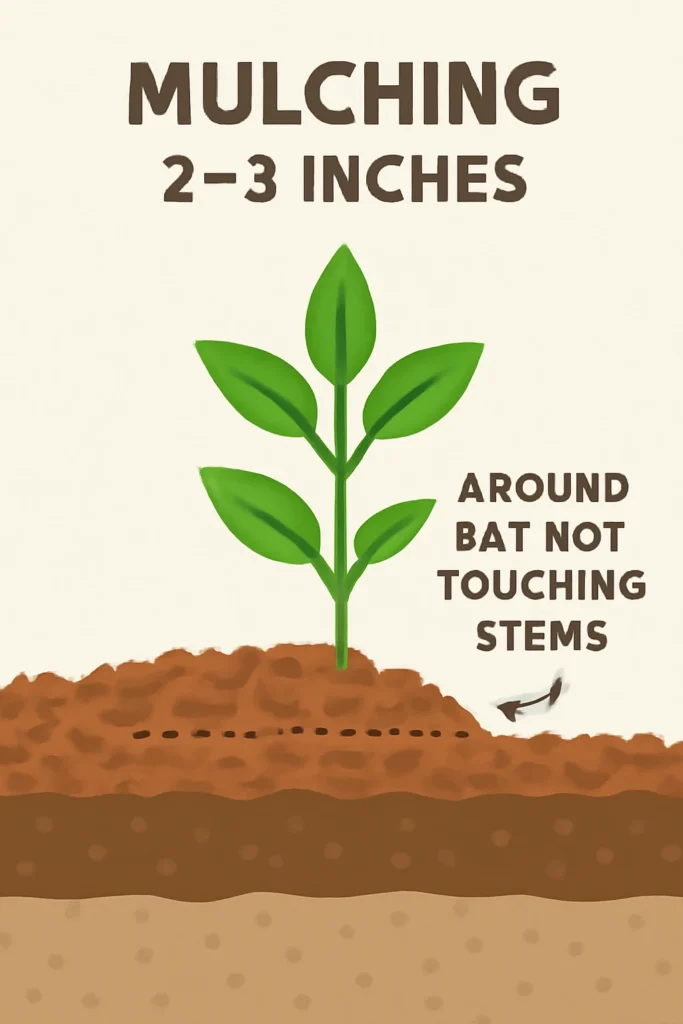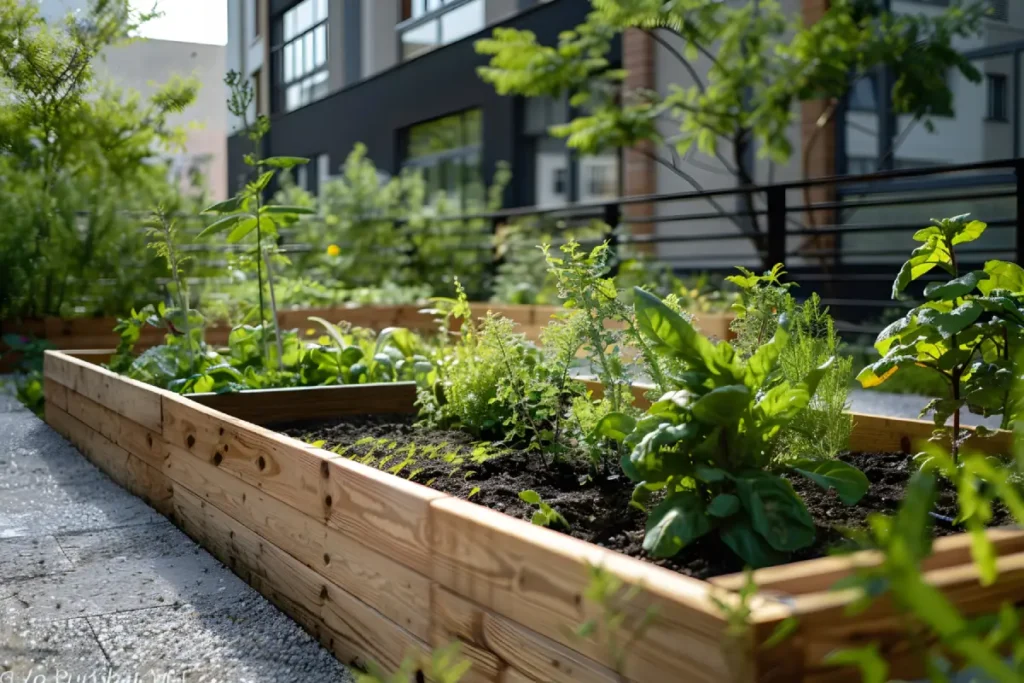Calculate Your Mulch Needs
Enter your garden details below to determine how much mulch you’ll need.
Your Results
💡 Mulching Tips
Maintain 2-4 inches of mulch for optimal weed suppression and moisture retention. Avoid piling mulch against plant stems or tree trunks.
Hardwood mulch is versatile and breaks down to enrich soil. Use for flower beds, vegetable gardens, and around trees and shrubs.
Mulch Calculation Report
Your personalized mulch calculation results
Calculation Results
- Calculate Your Mulch Needs
- Mulch Calculation Report
- Introduction
- What Is Mulch? (Beginner)
- Why Accurate Mulch Calculation Matters
- How Does a Mulch Calculator Work? (Informational)
- Step-by-Step: How to Use a Mulch Calculator
- Advanced Mulch Calculations (Expert)
- Choosing the Right Mulch for Your Yard
- Best Practices for Mulch Application
- Common Mulch Calculation & Mistakes (and How to Avoid Them)
- Final Thoughts
Introduction
If you’ve ever stood in front of a pile of mulch, unsure how much you need, you’re not alone. Finding the right amount of mulch for your yard can be tricky. It’s not just about picking up some bags from the store. If there is too little mulch, your plants may not get the needed moisture. Doing too much can actually cost you valuable time and hard-earned money. That’s where a mulch calculator comes in handy.
In this guide, we’ll walk you through everything you need to know—whether you’re new to gardening or you’ve been doing it for years. From understanding what mulch is to calculating exactly how much you need for your flower beds, trees, or playground, we’ve got you covered. You’ll learn how to use a mulch calculator, the importance of getting your measurements right, and why it’s a game-changer compared to guessing.
Using a mulch calculator isn’t just about precision—it’s about saving time, effort, and avoiding frustration. Let’s dive in and make your landscaping project a breeze!
What Is Mulch? (Beginner)

Mulch isn’t just about making your garden look nice—it’s also key to keeping plants healthy. Mulch is basically a layer of material spread over the soil. It generally falls into two categories: organic and inorganic.
Organic mulch comes from natural sources like bark, straw, compost, or wood chips. Over time, it decomposes, enriching the soil with nutrients. It’s perfect for retaining moisture, suppressing weeds, and improving soil quality. On the other hand, inorganic mulch includes materials like rubber, gravel, or landscape fabric. It doesn’t break down, but it helps with drainage and weed control, and it lasts longer without needing to be replaced.
Here’s a quick look at the benefits of both types:
| Mulch Type | Pros | Cons | Best Use |
| Organic | Moisture retention, soil enrichment, natural look | Needs replacement, decomposes over time | Flower beds, vegetable gardens, tree rings |
| Inorganic | Low maintenance, long-lasting, better for drainage | Can look artificial, doesn’t improve soil | Pathways, playgrounds, large landscaping areas |
Picking the right mulch depends on the specific needs of your yard or garden. If you’re focused on soil health and moisture, organic is the way to go. But if you're looking for something that lasts longer and requires less upkeep, inorganic mulch might be the better choice.
Why Accurate Mulch Calculation Matters
When it comes to mulching your yard, getting the amount just right is crucial. Using too little mulch can leave the soil bare, making it easier for weeds to sprout and moisture to disappear. Too much, and you risk suffocating your plants, not to mention wasting money and effort.
Accurate mulch calculation ensures your plants get the right amount of coverage to thrive, while also keeping costs in check. Using a mulch calculator can help you figure out exactly how much mulch you need, saving you time and preventing those extra trips to the garden store.
Take a look at this real-world example: imagine applying mulch to a flower bed without calculating the amount first. If you underestimate, the soil might dry out, leaving your plants vulnerable. If you overestimate, you could end up with a thick, soggy layer of mulch that’s doing more harm than good. A mulch calculator takes the guesswork out of the equation, ensuring you get it right every time.
By using a mulch calculator, you’re not just avoiding common mistakes; you’re investing in healthier plants and a more beautiful yard, all while saving money and reducing waste. It’s a win-win!
How Does a Mulch Calculator Work? (Informational)
A mulch calculator works by helping you determine exactly how much mulch you need for your specific project. The formula is simple: just consider the area to be covered and the mulch depth you want.
Here’s the basic formula:
Area (sq ft) × Depth (inches) ÷ 324 = Cubic Yards
Let’s break it down:
- Area (sq ft) refers to the total space you’re mulching. For example, if your flower bed is 10 feet by 6 feet, the area is 60 square feet.
- Depth (inches) is how thick you want the mulch to be. Generally, 2–4 inches is ideal for most applications.
- 324 is a constant that helps convert the measurement into cubic yards.
To visualize it, think of your mulch coverage like filling a box. The area is the base of the box, the Depth is how high you want it filled, and the cubic yards is the total volume of mulch needed.
A mulch calculator takes all these factors and gives you an accurate estimate, whether you’re working with bags or bulk. It saves you from guessing and ensures you buy just the right amount. Plus, many online calculators can even account for specific mulch types, slope adjustments, and irregular areas!
Step-by-Step: How to Use a Mulch Calculator

Using a mulch calculator is easy once you know the steps. Let’s walk through it so you can get it right the first time.
Step 1: Measure Your Area
First things first—measure the area you want to mulch. If you have a rectangular or square space, simply multiply the length by the width. For circular areas, you’ll need to use the formula for the area of a circle: π × radius².
Irregular spaces are easier to handle if you section them off into smaller areas. For example, if you have an oddly shaped garden bed, divide it into rectangles or circles and measure each one separately. It’ll make your calculation much more reliable.
Visual Example:
- For a rectangle: 10 feet x 5 feet = 50 square feet.
- For a circle with a 3-foot radius: π × (3 x 3) = 28.27 square feet.
Step 2: Choose the Right Mulch Depth
Now, you need to decide on the mulch depth. For most garden beds, 2–3 inches is ideal. But if you’re covering tree rings or paths, you may need a thicker layer. Here’s a quick reference for different uses:
| Application | Recommended Depth |
| Flower Beds | 2–3 inches |
| Trees & Shrubs | 3–4 inches |
| Playgrounds | 4–6 inches |
| Slopes | 3–4 inches |
Step 3: Enter Your Numbers
Next, take your measurements and plug them into an online mulch calculator. Most calculators will ask for the area (in square feet) and the desired Depth (in inches). Once you enter this information, the calculator will instantly tell you how many cubic yards of mulch you’ll need.
Visual Example:
- Area = 50 sq ft, Depth = 3 inches.
- The calculator will output: 0.46 cubic yards.
Step 4: Convert to Bags or Bulk
Once you have your cubic yards, you’ll need to convert that into bags or bulk, depending on how you’re buying your mulch. Typically, one cubic yard of mulch equals about 13–14 bags of mulch (each bag being two cubic feet). If you’re buying in bulk, your calculator will give you the number of cubic yards directly.
Quick Conversion:
- 1 cubic yard = 13–14 bags of mulch
- 1 cubic yard = about two truckloads of bulk mulch
Now you’re ready to grab exactly what you need for your project—no more guesswork!
Advanced Mulch Calculations (Expert)

Once you get the basics down, you can tackle more complex mulch projects with ease. Whether you're working with irregular shapes or sloped areas, here are some advanced tips for getting your calculations just right.
Calculating for Irregular Areas and Slopes
For irregular-shaped garden beds, the trick is breaking down the area into simpler shapes. Imagine you have a garden bed that's a mix of rectangles, circles, and odd shapes. You’ll calculate the area of each section separately and then add them together. This ensures an accurate estimate, even for tricky spaces.
For slopes, you’ll need to adjust your calculation by adding extra mulch to account for the angle. A good rule of thumb is to add about 10–30% more mulch for sloped areas, depending on how steep it is. This extra will help ensure the mulch stays in place and covers the area evenly.
Accounting for Settling and Waste
Mulch doesn’t stay at the same thickness forever. Over time, it can settle or break down, especially with organic materials. To account for this, consider adding 10% more mulch than your calculator suggests for new installations. This extra mulch will compensate for settling over time and help maintain the ideal Depth.
If you’re working on your first mulching project, it’s also smart to order a little extra to cover any waste or mistakes. It’s always better to have a little too much than too little, especially if you need to make a second trip to the store.
Mulch Type Considerations
The type of mulch you choose will affect how much you need. Different mulches have different densities and coverage rates. For example, shredded bark may cover more area than wood chips due to its finer texture. Some mulches may also compact more over time, reducing their volume.
Here’s a quick guide to the coverage you can expect for common mulch types:
| Mulch Type | Coverage per Cubic Yard |
| Shredded Bark | 80–100 sq ft (3-inch depth) |
| Wood Chips | 60–90 sq ft (3-inch depth) |
| Cocoa Hulls | 90–120 sq ft (3-inch depth) |
| Rubber Mulch | 100–125 sq ft (3-inch depth) |
Choosing the right mulch type can make a big difference in how far your mulch goes. So, always check the coverage recommendations before placing your order to avoid overbuying or underbuying.
Choosing the Right Mulch for Your Yard

Selecting the best mulch for your yard goes beyond just finding a good deal. It’s about matching the right material to your needs, whether that’s for your flower beds, vegetable garden, or even a playground.
Types of Mulch Explained
You can choose between two types of mulch: organic and inorganic.. Both have their advantages depending on your yard's requirements.
- Organic mulches like wood chips, bark, straw, and compost break down over time, enriching the soil with nutrients. These are ideal for flower beds, vegetable gardens, and around trees, where they improve soil quality and retain moisture.
- Inorganic mulches like gravel, rubber, and landscape fabric don’t decompose, which means they require less maintenance over time. These types are great for pathways, driveways, and large landscaping areas where long-term coverage and low upkeep are desired.
Matching Mulch to Your Landscape Needs
Different areas of your yard need different types of mulch. Here’s a quick guide on what works best for each application:
| Application | Best Mulch |
| Flower Beds | Organic mulches (bark, wood chips) |
| Vegetable Gardens | Compost or straw (for soil health) |
| Trees & Shrubs | Shredded bark or wood chips |
| Playgrounds | Rubber mulch (safe and durable) |
| Driveways & Paths | Gravel or rubber mulch |
Choosing the right mulch type can boost the aesthetic and health of your plants, so it’s worth considering the specific needs of each area in your yard.
Environmental and Cost Considerations
Beyond aesthetics and functionality, the environmental impact and cost of your mulch choices should also be factored in. Organic mulches are great for the environment because they break down and improve the soil, but they often require more frequent replacement. Inorganic mulches, while low-maintenance, can be less eco-friendly depending on the materials used.
Cost is another consideration—some mulches, like rubber, can be pricier upfront, but they last much longer than organic options. On the other hand, organic mulches may be more budget-friendly but need to be replenished more often.
By considering these factors, you’ll not only choose the best mulch for your yard but also make a smart, sustainable choice for your budget and the environment.
Best Practices for Mulch Application
Applying mulch might seem like a simple task, but doing it correctly can make all the difference in the health and appearance of your landscape. Here are some best practices to ensure your mulch is doing its job effectively.
Preparing Your Site
Before you spread mulch, take a few minutes to prepare your garden bed. Start by removing any weeds, grass, or old mulch that may be in the way. This step is important because it ensures that the mulch will have direct contact with the soil, allowing it to work its magic on moisture retention and soil enrichment.
Next, edge your garden bed to create a neat boundary for your mulch. This way, the mulch won’t spill into unwanted spots, and your garden gets a clean, finished touch.
How to Apply Mulch Correctly
When it comes to spreading mulch, the key is even distribution. Keep the mulch layer nice and uniform. For most plants, 2–3 inches is just the right Depth. Too much mulch can lead to waterlogging, while too little won’t provide the benefits you’re looking for.
One important tip: keep mulch away from plant stems and tree trunks. Mulch should be applied around, not against, the base of plants. This helps prevent rot and fungal growth, especially in moist conditions.

Maintenance and Renewal
Mulch doesn’t last forever. Over time, it will break down, decompose, or get washed away. This is especially true for organic mulches, which need to be replenished every year. Check your mulch regularly to make sure it’s still providing the necessary coverage.
If the mulch has settled or thinned out, just add a fresh layer to maintain the right Depth. For the best results, refresh your mulch before the growing season starts, so your plants can benefit from optimal moisture retention and weed suppression.
Keeping your mulch in check isn’t just about looks—it’s about creating a healthy, thriving garden environment. The right application and regular upkeep will keep your plants happy for years to come.
Common Mulch Calculation & Mistakes (and How to Avoid Them)

Even with the best of intentions, it's easy to make a few common mistakes when applying mulch to your garden. Let’s take a look at the most frequent missteps and how to avoid them.
Underestimating or Overestimating Area or Depth
One of the biggest mistakes is misjudging how much mulch you need. If you underestimate the area, you might run out halfway through the project. On the flip side, overestimating the area can leave you with piles of extra mulch that go to waste.
To avoid this, make sure you measure your space accurately. Use the right formula for area calculation—whether you’re working with rectangles, circles, or odd shapes—and always double-check your numbers before you place an order.
Ignoring Settling, Slopes, or Irregular Shapes
Sometimes people forget that mulch can settle over time, especially with organic types like wood chips or bark. Similarly, sloped areas often need extra mulch to ensure proper coverage.
When using a mulch calculator, remember to add an extra 10–30% for slopes or if you're working with an uneven, irregular shape. These adjustments ensure that your mulch covers everything it needs to and stays in place over time.
Creating "Mulch Volcanoes" Around Trees
Many gardeners go wrong by pushing mulch too close to the trunk, creating a “mulch volcano.” This can lead to moisture buildup, which can cause the tree’s bark to rot, or worse, invite pests and diseases.
Form a mulch ring around your tree, but don’t let it hug the trunk—leave a gap for a neat, donut-like shape.
Using the Wrong Mulch Type
Not every mulch works the same, and using the wrong kind can leave your garden struggling. For example, rubber mulch is great for pathways but isn’t ideal for vegetable gardens because it doesn’t enrich the soil.
Before buying mulch, always consider the needs of your garden. Organic mulches boost soil health and help plants thrive, while inorganic options work best in low-maintenance spots.
Stay mindful of these pitfalls, and your mulch will help create a garden that’s both stunning and full of life.
Final Thoughts
So, choosing the right mulch for your yard doesn’t have to be complicated, right? With a mulch calculator, you can easily figure out how much you need, no more guessing! Whether you're looking to boost your garden’s look, keep the moisture in, or protect the soil, it all starts with getting the right amount. And honestly, taking just a few minutes to use a mulch calculator can save you time, effort, and money. It’s like giving your garden the perfect foundation. So, grab that calculator and let your yard flourish with the ideal mulch!
How do I calculate how much mulch I need?
To calculate the amount of mulch you need, you’ll need to measure the area you want to cover and decide on the desired Depth. Use this formula:
Area (sq ft) × Depth (in inches) ÷ 324 = Cubic Yards.
A mulch calculator will help you simplify this process by plugging in your measurements and providing an accurate estimate.
What’s the ideal Depth of mulch for healthy plants?
The ideal mulch depth typically ranges between 2 and 4 inches. For flower beds and vegetable gardens, 2–3 inches is usually enough. For trees and shrubs, 3–4 inches can help provide better moisture retention and weed control.
How many bags of mulch are in a cubic yard?
One cubic yard of mulch generally equals about 13–14 bags, depending on the size of the bags. If you’re buying mulch in bulk, your mulch calculator can also tell you how many cubic yards you need, making it easy to convert that into bags.
Can I use a mulch calculator for irregular shapes?
Yes, a mulch calculator can handle irregularly shaped areas. To do this, simply break down the area into simpler shapes (rectangles, circles) and calculate the area of each section before adding them together. Many calculators have options for handling complex shapes.
Why is a mulch calculator important for gardening projects?
Using a mulch calculator ensures you buy just the right amount, saving time and money. It avoids issues like plant damage from too much or too little mulch and makes the whole process simpler for gardeners of all levels.
How often should I replace my mulch?
Organic mulches don’t last forever—they decompose and should be replaced every year or so. Inorganic mulches can last longer but may need occasional refreshing to maintain their appearance and effectiveness. Keep an eye on your mulch each season to determine when it’s time for a top-up.
Related Calculator

